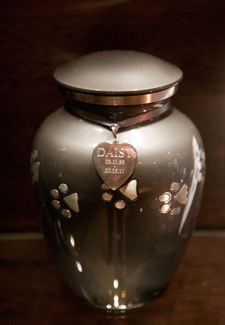On Private Pet Cremation
Published on September 16, 2014
Skip To

When the time comes to answer that question, most of us aren’t thinking rationally. Things seems so awful and unreal that we’re not likely to know how to respond — not when asked to decide how we’ll deal with the profoundly disquieting details of handling our pet’s physical remains.
In case you’re rusty on the options, here are the top three choices you’ll face at the time of your pet’s death:
- Cremation of your pet with her particular cremains (ashes) returned to you (often referred to as a private or individual cremation).
- Cremation of your pet with other pets (called communal cremation), in which
case you won’t
receive her unique cremains.
- Burial of your pet in a pet cemetery or
on your own
property. (This last choice may not be legal in your
municipality.)
I’m a big fan of the private approach. Though it’s more expensive, I think it’s worth it. When you receive your pet’s cremains, you can breathe a sigh of relief. You can put off the issue of what to do with the ashes for a few days, weeks, months or even years (as I’ve done). The cremains will always be yours to memorialize however you please once you’re in a more sound state of mind.
Understanding the Process
In case you’ve never faced this decision and have no idea what a private cremation entails, let me explain.1. Almost all veterinary hospitals have a relationship with a regulated establishment that offers a cremation chamber (a special kind of furnace) used exclusively for pet cremation. The service will pick up your pet’s body at your vet’s office and take it to the facility where this cremation equipment is housed.
2. In the case of private cremation, a pet is placed inside the chamber by herself so that her ashes will not intermingle with others or be mistaken for another’s.
3. The chamber is then heated to 1,500 to 1,600 degrees, a process which results in evaporation within the cremation chamber to yield the cremated remains. These cremains are further processed and packaged for ease of storage and transportation.
The process is actually clean and clinical when done correctly.
Don’t believe me? Consider asking your local animal crematory whether it offers a “viewing” cremation service. In these cases, owners, family and friends are allowed to attend a cremation. Not all crematoriums offer a viewing option, but it’s becoming more commonplace.
You Can Take Her With You
The tangibility and flexibility of individual pet cremation makes it ideal for our mobile lifestyles. Who wants to bury a pet in North Carolina when you might be moving to New York in the not-too-distant future? Perhaps this explains why I’ve always elected individual cremation for my pets — and why pet owners are increasingly electing it for their pets, too.I’ve always felt that having some part of my pets near me helped pay tribute to their lives in some special way. I know they’re just bones, but for me, a collar, some hair clippings and a slew of photographs weren’t enough. I needed something more direct, more ceremonial, more substantial somehow.
The only drawback? Deciding what to do with them.
Now that cremains have become almost the default choice in the eyes of many veterinarians and pet owners alike, it only makes sense we’d have more choices than we know what to do with: urns, gemstones, lockets, headstones… need I go on?
When the time comes, what will you choose to do?





